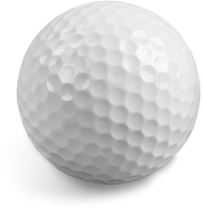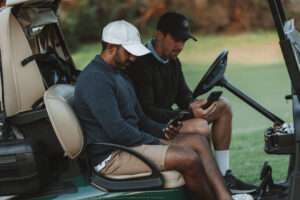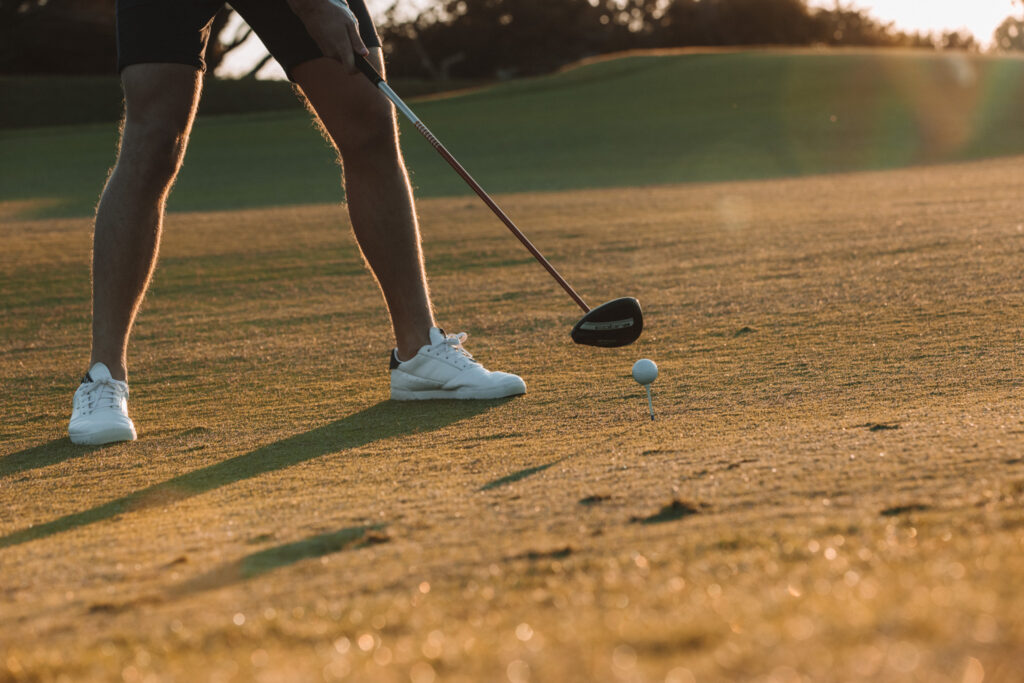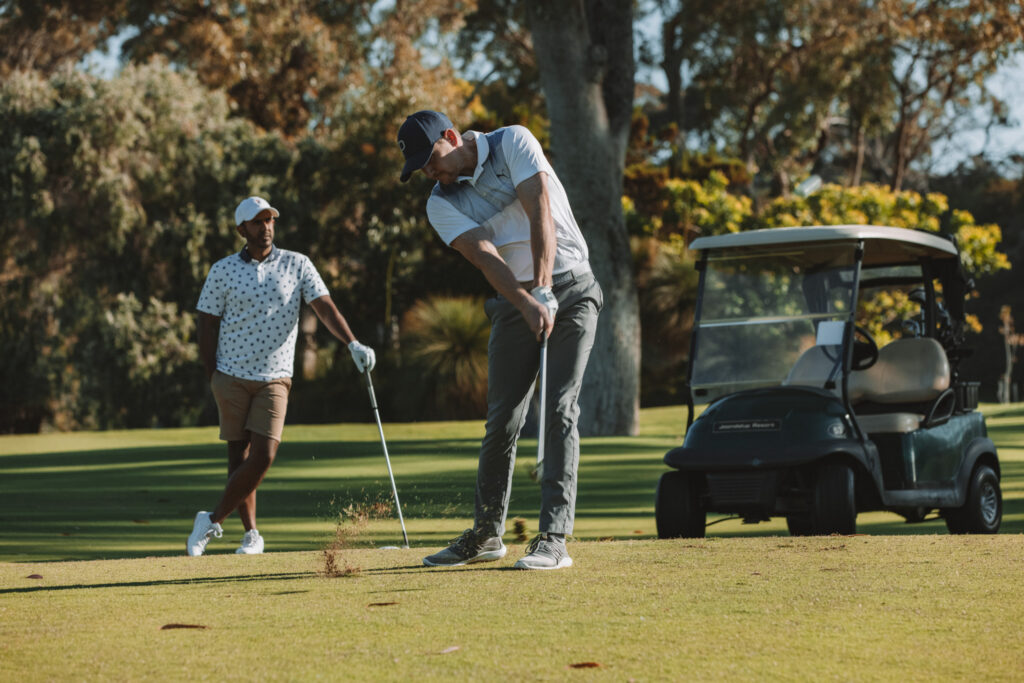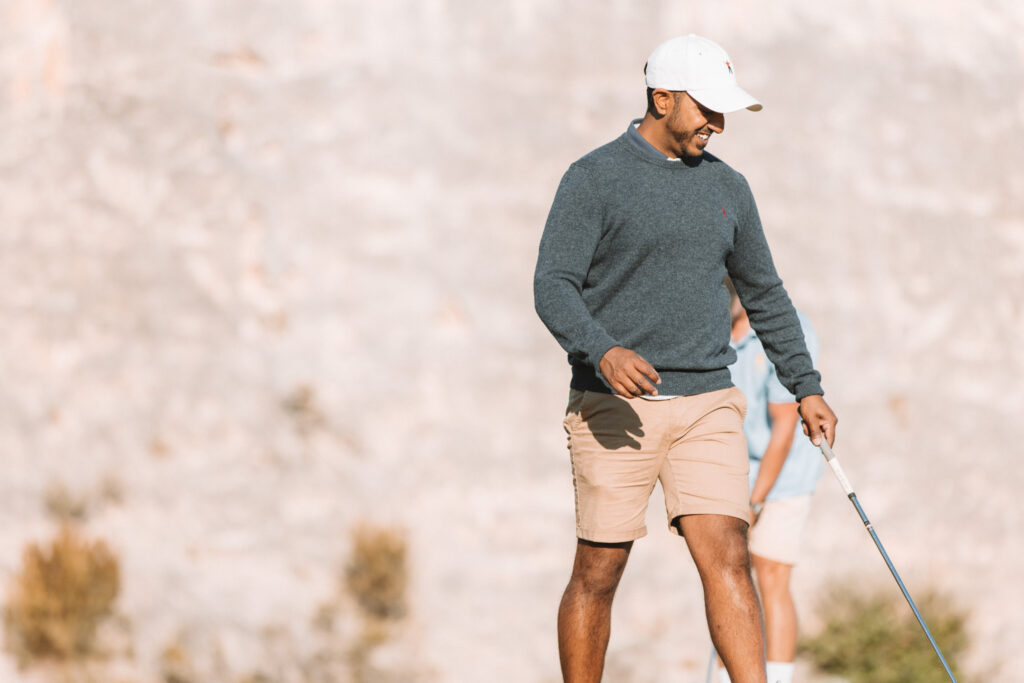The Most Common Swing Mistakes and How to Fix Them
A great golf swing is built on solid fundamentals, but even small flaws in mechanics can lead to inconsistency, poor contact, and frustrating rounds. The good news? Most swing mistakes are fixable—once you understand what’s causing them.
In this guide, we’ll break down the most common swing mistakes, why they happen, and practical fixes to help you hit more solid shots with confidence.
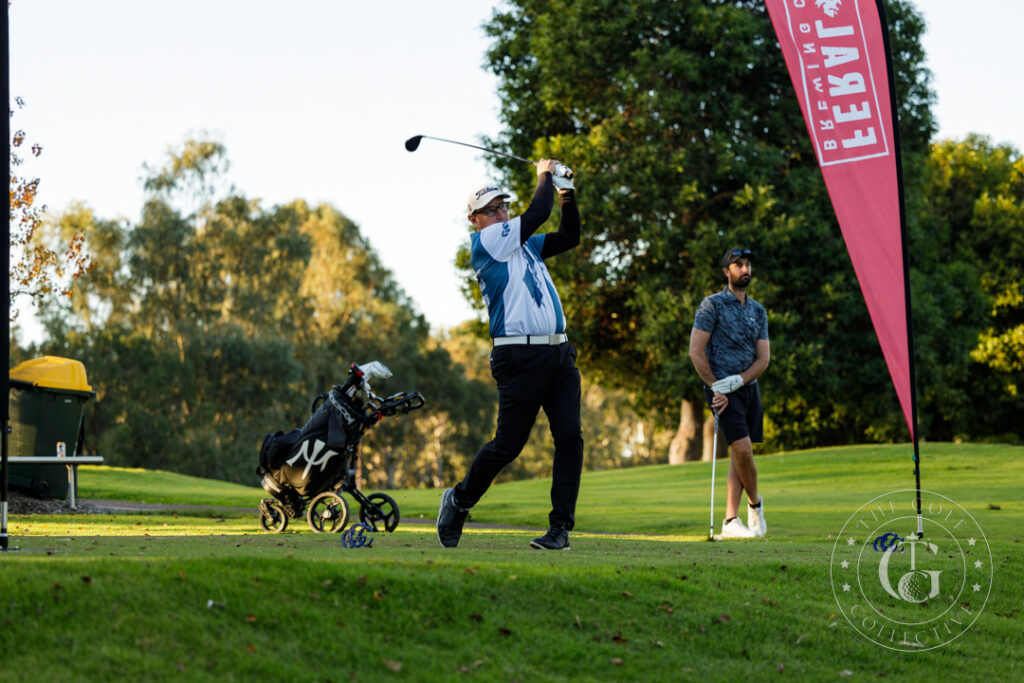
1. The Over-the-Top Move
One of the biggest causes of inconsistency, the over-the-top move is when the upper body starts the downswing by throwing the club outward, leading to an outside-to-in swing path. This often results in slices, pulls, and weak contact.
Why Does the Over-the-Top Move Happen?
The over-the-top move is one of the most common swing mistakes in golf. It happens when the upper body starts the downswing by throwing the club outward, leading to an outside-to-in swing path. This often results in slices, pulls, weak shots, and inconsistency.
To fix it, you first need to understand what’s causing it. Here are five key reasons golfers swing over the top, along with ways to correct each issue.
1. Poor Transition from Backswing to Downswing
The downswing should start from the ground up, with the lower body leading the movement. However, many golfers initiate the downswing with their shoulders and arms, which causes the club to move outward instead of shallowing naturally.
How to Fix It:
✅ Feel like your downswing starts from the ground up—hips, then torso, then arms.
✅ Try the “Pause Drill” – At the top of your backswing, pause briefly, then start your downswing by shifting your weight into your lead foot before your arms move.
✅ Film your swing – If your first movement is with your shoulders, you’re likely coming over the top.
2. Poor Arm Structure in the Backswing
If your arms are too disconnected from your body in the backswing—meaning your hands move too far away from your torso—it sets you up for an over-the-top downswing. Instead of allowing the club to drop naturally, your body compensates by throwing the club out and over the plane.
How to Fix It:
✅ Keep your arms connected to your chest throughout the swing.
✅ Use the Towel Drill – Place a towel under both arms while making slow swings. If the towel drops, your arms are too disconnected.
✅ Focus on a compact backswing – A shorter, controlled backswing helps prevent excessive movement that leads to over-the-top swings.
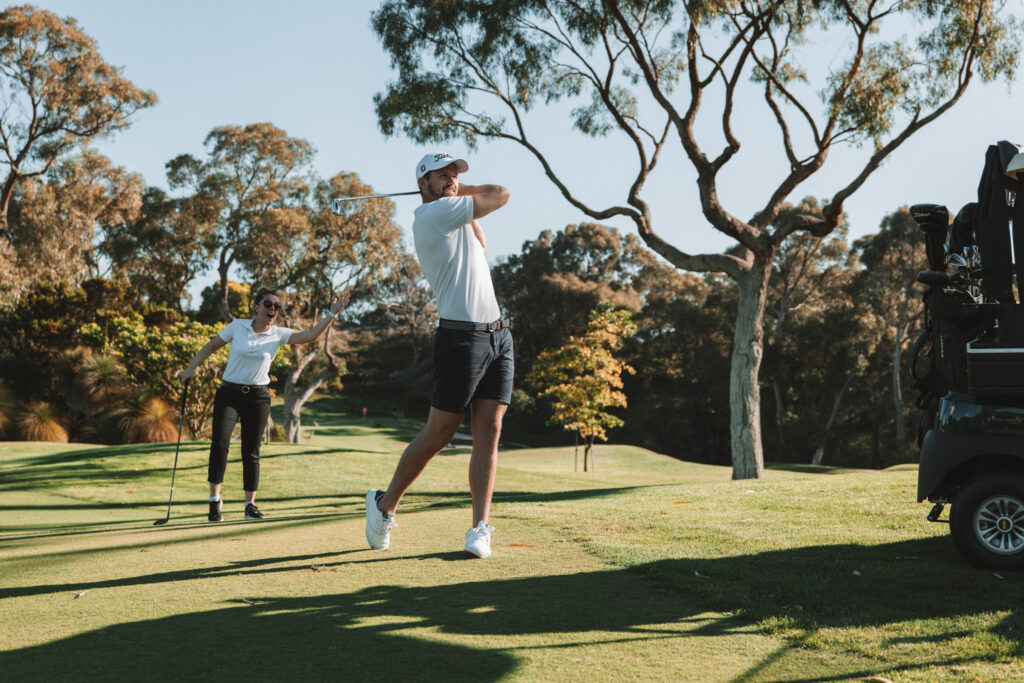
3. Improper Clubface Position at the Top
A clubface that’s too open at the top of the backswing forces golfers to compensate by swinging over the top to square the face at impact. This is a classic cause of slicing.
How to Fix It:
✅ Check your wrist angle – At the top of your swing, your lead wrist should be flat, not cupped.
✅ Feel like you’re bowing your wrist slightly at the top to promote a square face.
✅ Strengthen Your Grip – If you struggle with an open face, rotating your lead hand slightly so you see two or three knuckles at address can help.
4. Lack of Hip Rotation in the Downswing
When the hips don’t rotate properly in the downswing, the upper body takes over, forcing the club over the top rather than into a proper inside path. This is often due to stiffness, poor sequencing, or an instinct to steer the ball.
How to Fix It:
✅ Focus on clearing your hips first – Feel like your lead hip is turning toward the target before your arms start down.
✅ Use the “Step-Through Drill” – Take a small step toward the target as you start the downswing. This encourages proper lower body movement.
✅ Stretch Your Hips Before Your Round – Hip mobility drills, like seated hip rotations, can help improve flexibility and rotation.
5. Ball Position Too Far Forward
If the ball is too far forward in your stance, it encourages a late release, which can make it difficult to shallow the club properly. This often leads to an over-the-top motion as the body tries to reach the ball at impact.
How to Fix It:
✅ For drivers, position the ball just inside your lead heel.
✅ For irons, the ball should be in the middle or slightly forward for longer irons.
✅ Experiment with different positions on the range to find what allows for the best contact and natural club path.
2. A Weak Grip
Your grip is the only connection between you and the club, so if it’s weak, you’ll struggle to control the clubface. A weak grip means the hands are turned too far toward the target, often leading to an open clubface at impact, weak shots, and slices.
Why It Happens:
- Holding the club too much in the palm instead of the fingers.
- Trying to guide the ball instead of releasing naturally.
- Lack of awareness of proper hand positioning.
How to Fix It:
✅ Check Your Knuckles – At address, you should see two to three knuckles on your lead hand.
✅ Grip More in the Fingers – The club should rest more in your fingers than your palm, allowing for better wrist hinge and release.
✅ Pressure Test – Hold the club at a 5 out of 10 grip pressure—too tight and your hands won’t release properly, too loose and you lose control.
3. Poor Posture at Address
A bad setup leads to bad swings before the club even moves. Poor posture—like standing too upright or hunching over too much—causes balance and rotation issues, making it harder to make a repeatable swing.
Standing Too Tall or Crouching Too Much
The ideal golf posture is a balanced, athletic stance, but many players either:
- Stand too upright – This limits hip rotation, making it difficult to generate power and forcing an over-the-top swing path.
- Hunch over too much – This causes tension in the upper body, restricting movement and making it hard to stay balanced.
How It Affects Your Swing:
❌ If you stand too tall, you might feel like you’re swinging “around” your body rather than making a proper turn. This often results in thin shots or inconsistent ball striking.
❌ If you hunch over, your arms and shoulders dominate the swing, leading to weak contact and difficulty maintaining balance through impact.
✅ Fix It:
✔ Bend slightly from your hips, not your waist, keeping your spine straight.
✔ Let your arms hang naturally instead of reaching too far for the ball.
✔ Feel like your chest is slightly over your toes, not leaning too far back or too far forward.
2. Too Much Weight on the Heels or Toes
Good posture includes proper weight distribution, but many golfers get this wrong:
- Too much weight on your heels – Causes a loss of balance, making it difficult to rotate properly.
- Too much weight on your toes – Leads to early extension, where your body moves toward the ball during the downswing, causing inconsistent contact.
How It Affects Your Swing:
❌ If your weight is too far back (heels), you might feel “stuck” in your swing, leading to blocks or weak shots.
❌ If your weight is too far forward (toes), you might struggle with thin shots or an over-the-top move.
✅ Fix It:
✔ At setup, your weight should be centred over the balls of your feet, not too far back or forward.
✔ A simple test: If someone nudges you gently, you should feel stable—not like you’re about to tip forward or backwards.
3. Not Enough Knee Flex or Hip Tilt
Knee flex and hip tilt help you create a stable base for a powerful, repeatable swing.
- Too little knee flex – Leads to stiffness, making it harder to rotate properly.
- Too much knee flex – Can make your stance too low, restricting movement.
How It Affects Your Swing:
❌ If your knees are too straight, your lower body won’t engage properly, leading to poor weight transfer and a lack of power.
❌ If you squat too much, your legs get “stuck,” making it harder to turn effectively and maintain balance.
✅ Fix It:
✔ Slightly flex your knees—they should be relaxed, not locked or bent too much.
✔ Tilt your hips forward slightly so your spine stays straight and neutral.
5. Casting the Club (Early Release)
Casting is when the wrists unhinge too early in the downswing, leading to a loss of lag and weak, high shots with no power. This often results in thin or fat shots and a lack of distance.
Why It Happens:
- Not maintaining wrist hinge in the downswing.
- Trying to “scoop” the ball instead of compressing it.
- Poor sequencing—arms moving before the lower body.
How to Fix It:
✅ Hold the Angle Longer – Feel like your wrists stay hinged until your hands are close to your trail thigh in the downswing.
✅ Towel Under the Trail Arm Drill – Keep a towel tucked under your trail arm to encourage a connected downswing and better wrist lag.
✅ Think “Hit Down, Not Scoop” – The club should compress the ball before hitting the ground, not the other way around.
6. Hanging Back on the Trail Foot
Many golfers fail to transfer their weight properly, leaving too much weight on their back foot at impact. This leads to fat shots, thin shots, and inconsistent contact.
Why It Happens:
- Not shifting weight forward in the downswing.
- Trying to lift the ball into the air instead of compressing it.
- Poor sequencing—upper body moving before lower body.
How to Fix It:
✅ Feel Like You Finish on Your Front Foot
One of the simplest ways to correct weight transfer issues is to hold your finish position after every shot. At the end of your swing:
- Your lead foot should feel like it’s carrying most of your weight (around 90% of it).
- Your back foot should be on its toes, with almost no weight remaining on it.
- Your chest and belt buckle should be facing the target—not tilted backward.
Why This Works:
When you consciously check your finish position, your body starts learning the correct movement pattern. If you’re falling backward or feel like your weight is still on your trail foot, it’s a clear sign that you need to shift forward more aggressively during your downswing.
✅ Step-Through Drill
This is one of the best drills to train proper weight shift. Here’s how to do it:
- Set up as normal with a mid-iron (7 or 8-iron).
- Swing as you normally would, but after impact, step forward with your trail foot toward the target.
- Feel how your weight naturally moves forward instead of staying back.
Why This Works:
- Forces you to shift weight onto your lead side before impact.
- Prevents falling backward after the shot.
- Encourages a natural, athletic motion, eliminating stiffness.
✅ Pro Tip: Exaggerate the step at first, then gradually reduce it as your body learns proper weight transfer.
✅ Trust the Loft of the Club
Many golfers try to “help” the ball into the air by leaning back or flipping their wrists through impact. This is a mistake. The loft of the club is designed to get the ball airborne without you having to manipulate it.
Instead of scooping the ball:
- Feel like you’re hitting down and through the ball.
- Let the clubface do its job—compressed shots create a higher, more controlled flight.
- Focus on brushing the grass in front of the ball, not behind it.
Why This Works:
- Encourages better ball-first contact instead of hitting the ground behind the ball.
- Helps create solid, crisp iron shots with a natural trajectory.
- Prevents thin or fat shots caused by improper weight shift.
✅ Pro Tip: Place a tee or alignment stick a few inches in front of the ball and try to swing through the ball to that point. This helps encourage proper forward shaft lean and weight transfer.
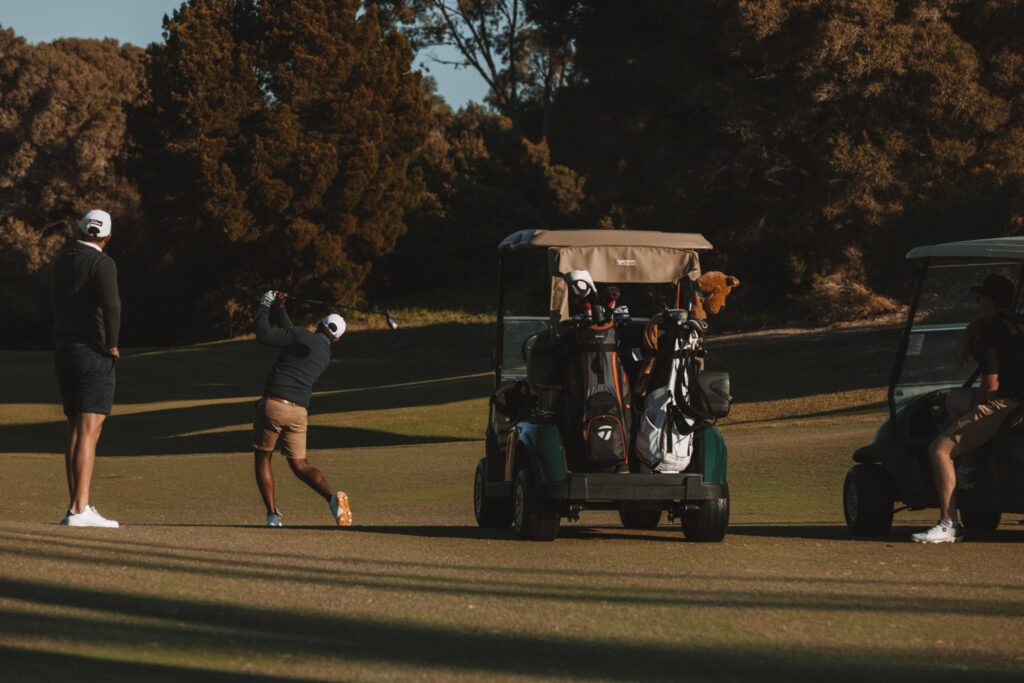
Final Thoughts: Fixing Swing Mistakes for Good
Every golfer makes swing mistakes, but the best players aren’t perfect—they’re just better at recognizing their flaws and making small, consistent corrections. Improvement comes from understanding your swing, practising with intent, and trusting the process.
Next time you’re at the range:
✔ Identify the fundamental mistake that’s affecting your swing.
✔ Use one of the drills above to make a small but meaningful adjustment.
✔ Focus on progress, not perfection—even the best players are always refining their game.
If you’re struggling to make the right adjustments or want personalized guidance, consider working with Glenn Paul, a professional golfer and experienced coach who partners with The Golf Collective. Glenn specializes in helping players of all levels fine-tune their swing mechanics, improve consistency, and develop a more reliable golf game.
You can learn more about Glenn and book a lesson at www.glennpaul.com.au.
Remember, golf isn’t about hitting every shot perfectly—it’s about making fewer mistakes and improving step by step. Stick with it, keep learning, and watch your scores start to drop!

